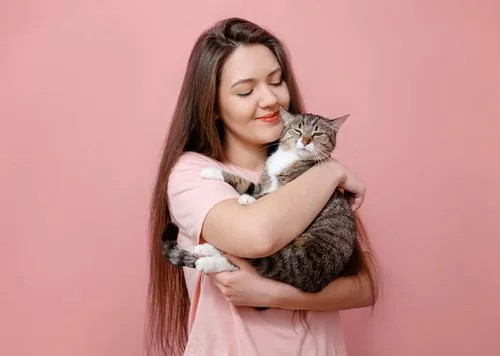It can be worrying to notice unusual traits in your cat, especially if they affect their behavior or appearance. You might wonder if your feline friend could have Down syndrome. While it’s natural to seek answers and compare conditions across species, it’s important to understand that human and feline genetics are different. While cats cannot have Down syndrome in the same way humans do, they can experience genetic and neurological conditions that present with similar characteristics. Let’s explore the realities of cat health and understand what might be behind those unexpected quirks you observe in your beloved pet.
 A young woman lovingly cradles a cat, illustrating the care and affection needed for cats who may exhibit Down syndrome-like traits due to genetic or congenital conditions.
A young woman lovingly cradles a cat, illustrating the care and affection needed for cats who may exhibit Down syndrome-like traits due to genetic or congenital conditions.
Why Cats Can’t Have Down Syndrome (Genetics Explained)
Down syndrome in humans is a genetic disorder caused by an extra copy of chromosome 21. This additional genetic material leads to a range of physical and intellectual differences. However, the genetic makeup of cats is distinctly different from humans. Humans have 23 pairs of chromosomes, while cats have only 19 pairs. Crucially, cats do not have a chromosome 21 that corresponds to the human chromosome affected in Down syndrome.
Therefore, due to these fundamental differences in genetics, cats cannot develop Down syndrome as it’s defined and understood in humans. The genetic mechanisms behind Down syndrome are specific to human chromosomal structure and do not translate to feline genetics.
Understanding “Down Syndrome-Like” Traits in Cats
Despite not having Down syndrome, some cats exhibit traits that might superficially resemble characteristics seen in humans with the condition. These can include distinct facial features, delays in development, or differences in behavior. It’s important to recognize that these traits in cats arise from various other health issues – genetic conditions unique to cats, congenital problems present from birth, or even environmental factors – and not from Down syndrome itself.
What Causes These “Down Syndrome-Like” Symptoms?
When a cat presents with symptoms that might remind you of Down syndrome, the actual causes can be diverse and complex. These underlying issues can be categorized as follows:
- Genetic Abnormalities in Cats: Just like humans, cats can experience unique genetic mutations. These mutations are unrelated to human Down syndrome but can result in a variety of physical and behavioral variations. These feline-specific genetic issues can sometimes manifest in ways that are visually or behaviorally similar to some aspects of Down syndrome.
- Congenital Defects Present at Birth: Congenital defects are birth defects that occur as a kitten develops in the womb. These defects can lead to physical and neurological differences, such as an unusually shaped skull, cognitive impairments, and various other developmental challenges. These are not linked to Down syndrome but are conditions a cat is born with.
- Infections During Pregnancy: If a mother cat contracts certain infections while pregnant, these infections can interfere with the healthy development of her kittens. Such infections can lead to a spectrum of abnormalities in the kittens, some of which might be mistakenly associated with Down syndrome due to overlapping symptoms.
- Exposure to Toxins: Exposure to toxins in the environment during pregnancy can also negatively impact kitten development. This exposure can result in physical deformities or neurological problems in kittens, again leading to symptoms that might superficially resemble those seen in Down syndrome, although the underlying cause is environmental rather than genetic in the Down syndrome sense.
It’s crucial to remember that while these conditions can produce symptoms that may appear similar to Down syndrome, they are fundamentally different conditions with distinct causes, requiring specific approaches to veterinary care and management.
Recognizing Potential Signs in Cats: What to Look For
Identifying potential genetic or congenital conditions in cats involves careful observation of their physical characteristics and behaviors. Cats with these conditions might exhibit a range of signs:
Distinct Facial Features
Some cats may have facial features that are considered unusual for their breed or cats in general. These can include:
- Flattened Nose: A nose that appears flatter than typical for cats.
- Wide-Set Eyes: Eyes that are spaced further apart than commonly seen.
- Smaller Jaw: A jaw that seems underdeveloped or smaller in proportion to their face.
While these facial traits are sometimes mistakenly linked to Down syndrome in online discussions, they are more likely indicators of other genetic or developmental issues in cats.
Developmental Delays
Pay attention to your kitten’s developmental milestones. Cats experiencing developmental delays might:
- Be Slower to Develop Motor Skills: They may take longer to achieve typical motor skills like walking steadily, jumping, or coordinating movements.
- Exhibit Delayed Cognitive Abilities: They might be slower to learn basic behaviors, such as using the litter box consistently, engaging in play, or responding to human interaction.
These delays suggest potential underlying congenital or genetic conditions that require veterinary evaluation.
Behavioral Differences
Unusual behaviors can also be a sign of underlying neurological issues. Observe if your cat exhibits:
- Repetitive Movements: Engaging in actions repeatedly without apparent purpose.
- Difficulty in Coordination: Appearing clumsy, struggling with balance, or having uncoordinated movements.
- Lack of Responsiveness to Stimuli: Showing reduced reactions to sounds, sights, or touch.
These behavioral differences are not indicative of Down syndrome but rather point towards other neurological or genetic issues that need professional veterinary assessment.
The Importance of Veterinary Consultation
If you observe any of the symptoms mentioned above in your cat, it is essential to consult with a veterinarian. A veterinary professional can conduct a thorough physical examination and may recommend specific diagnostic tests, including genetic testing in some cases, to accurately determine the underlying cause of your cat’s symptoms. Proper diagnosis is crucial for providing the right care and management plan tailored to your cat’s specific needs.
Caring for Cats with Special Needs: Enhancing Their Quality of Life
Cats with genetic or congenital conditions may require additional care and attention to ensure they live comfortable and fulfilling lives. Here are key aspects of care:
Regular Veterinary Care
Consistent veterinary visits are vital. Routine wellness exams help in managing any ongoing health concerns and in detecting new issues early. Your veterinarian can provide personalized advice and guidance based on your cat’s specific condition and needs.
Customized Diet and Environment
Some cats with developmental delays or physical challenges benefit significantly from a tailored approach to their diet and environment. This may involve:
- Specialized Diet: A diet formulated to address specific nutritional needs or health conditions.
- Adapted Environment: Modifying their living space to be more accessible and safe. For example, providing easily reachable food and water bowls and litter boxes, especially for cats with mobility limitations.
Enrichment and Socialization
Engaging your cat in regular play and social interaction is highly beneficial, particularly for cats with cognitive or behavioral differences. Enrichment activities and socialization:
- Stimulate their Minds: Help keep them mentally active and engaged.
- Aid in Environmental Adaptation: Support their adjustment to their surroundings and daily routines.
Creating a Supportive Home Environment: Practical Tips
Creating a supportive home environment is crucial for special needs cats. Consider these practical adjustments:
- Safe Havens: Ensure your home includes quiet, secure areas where your cat can retreat and feel safe. These spaces should be away from busy areas and equipped with comfortable bedding.
- Accessibility: Place essential resources like food, water, and litter boxes in easily accessible locations. Use ramps or steps to help cats with mobility issues reach their preferred spots without strain.
- Gentle Handling: Be mindful of how you handle your cat, especially if they have physical sensitivities or deformities. Use slow, gentle movements to minimize stress and prevent potential injuries.
Cats with special needs, whether due to genetic, congenital, or environmental factors, thrive with a compassionate and understanding approach to their care. With proper care, attention, and a supportive home environment, cats with unique needs can live happy, enriched lives. If you have any concerns about your cat’s health or believe they may have a condition that presents with “Down syndrome-like” traits, please reach out to your veterinarian for professional guidance and support.


